warning light TOYOTA YARIS HATCHBACK 2020 (in English) Workshop Manual
[x] Cancel search | Manufacturer: TOYOTA, Model Year: 2020, Model line: YARIS HATCHBACK, Model: TOYOTA YARIS HATCHBACK 2020Pages: 572, PDF Size: 7.94 MB
Page 173 of 572
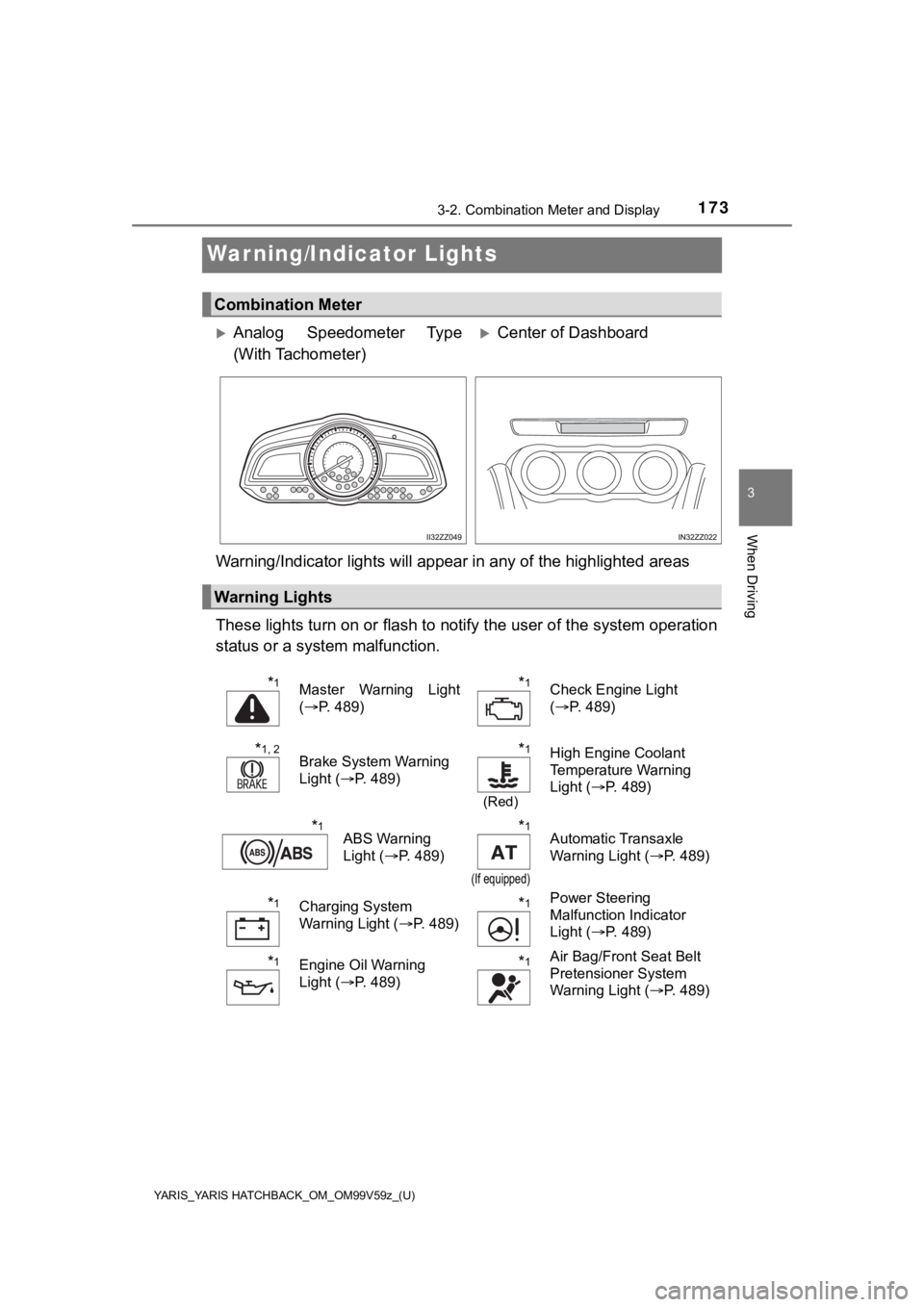
173
YARIS_YARIS HATCHBACK_OM_OM99V59z_(U)
3-2. Combination Meter and Display
3
When Driving
Warning/Indicator Lights
Warning/Indicator lights will appear in any of the highlighted areas
These lights turn on or flash to notify the user of the system operation
status or a system malfunction.
Combination Meter
Analog Speedometer Type
(With Tachometer)Center of Dashboard
Warning Lights
*1Master Warning Light
( P. 489)*1Check Engine Light
(P. 489)
*1, 2Brake System Warning
Light ( P. 489)*1
(Red)
High Engine Coolant
Temperature Warning
Light (P. 489)
*1ABS Warning
Light (P. 489)*1
(If equipped)
Automatic Transaxle
Warning Light ( P. 489)
*1Charging System
Warning Light (P. 489)*1Power Steering
Malfunction Indicator
Light (P. 489)
*1Engine Oil Warning
Light (P. 489)*1Air Bag/Front Seat Belt
Pretensioner System
Warning Light ( P. 489)
Page 174 of 572
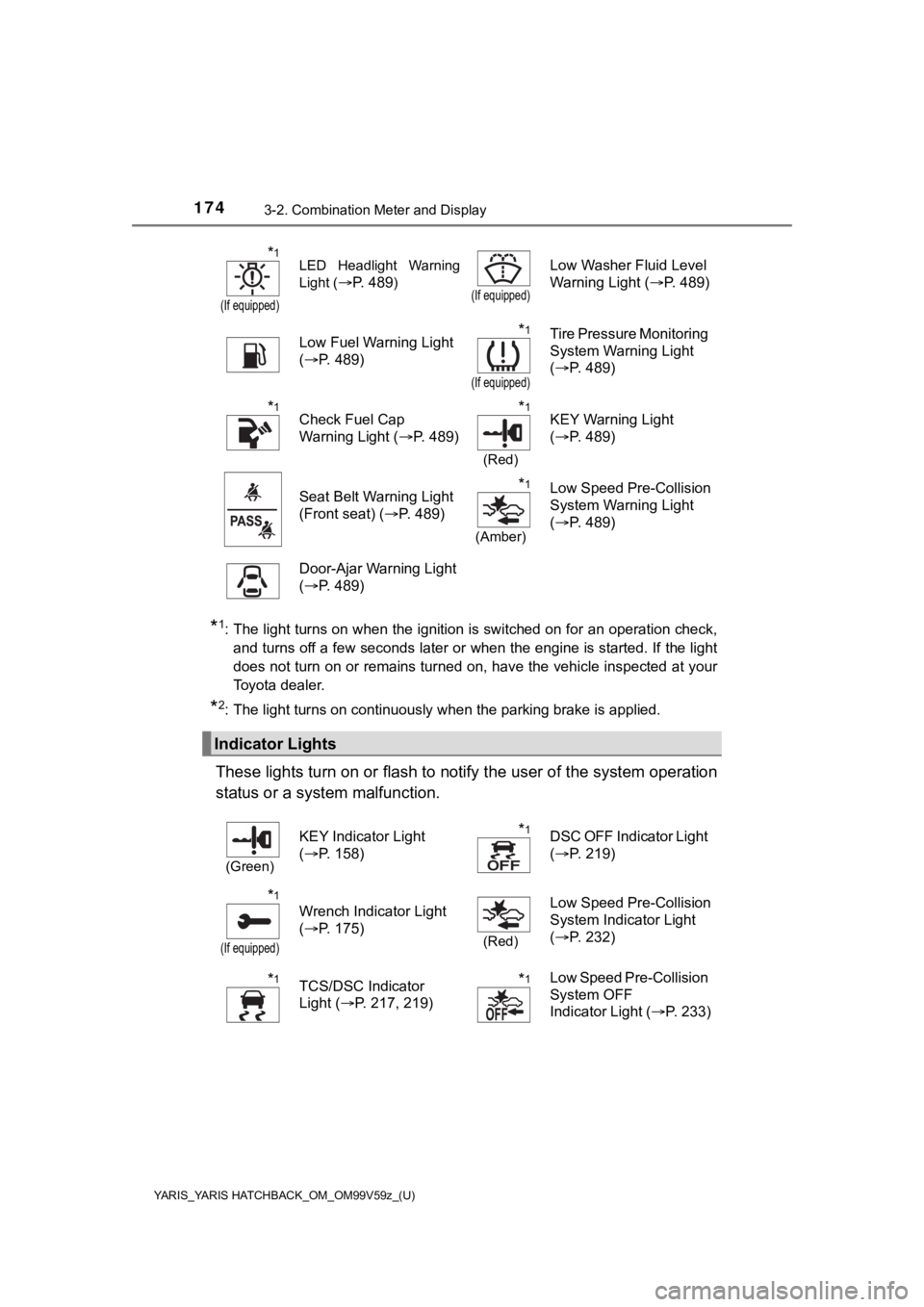
174
YARIS_YARIS HATCHBACK_OM_OM99V59z_(U)
3-2. Combination Meter and Display
*1: The light turns on when the ignition is switched on for an operation check,
and turns off a few seconds later or when the engine is started . If the light
does not turn on or remains turned on, have the vehicle inspect ed at your
Toyota dealer.
*2: The light turns on continuously when the parking brake is appl ied.
These lights turn on or flash to notify the user of the system operation
status or a system malfunction.
*1
(If equipped)
LED Headlight Warning
Light (
P. 489)(If equipped)
Low Washer Fluid Level
Warning Light ( P. 489)
Low Fuel Warning Light
( P. 489)
*1
(If equipped)
Tire Pressure Monitoring
System Warning Light
(P. 489)
*1Check Fuel Cap
Warning Light ( P. 489)*1
(Red)
KEY Warning Light
(P. 489)
Seat Belt Warning Light
(Front seat) ( P. 489)
*1
(Amber)
Low Speed Pre-Collision
System Warning Light
(P. 489)
Door-Ajar Warning Light
( P. 489)
Indicator Lights
(Green)
KEY Indicator Light
(P. 158)*1DSC OFF Indicator Light
(P. 219)
*1
(If equipped)
Wrench Indicator Light
(P. 175)
(Red)
Low Speed Pre-Collision
System Indicator Light
(P. 232)
*1TCS/DSC Indicator
Light ( P. 217, 219)*1Low Speed Pre-Collision
System OFF
Indicator Light ( P. 233)
Page 175 of 572
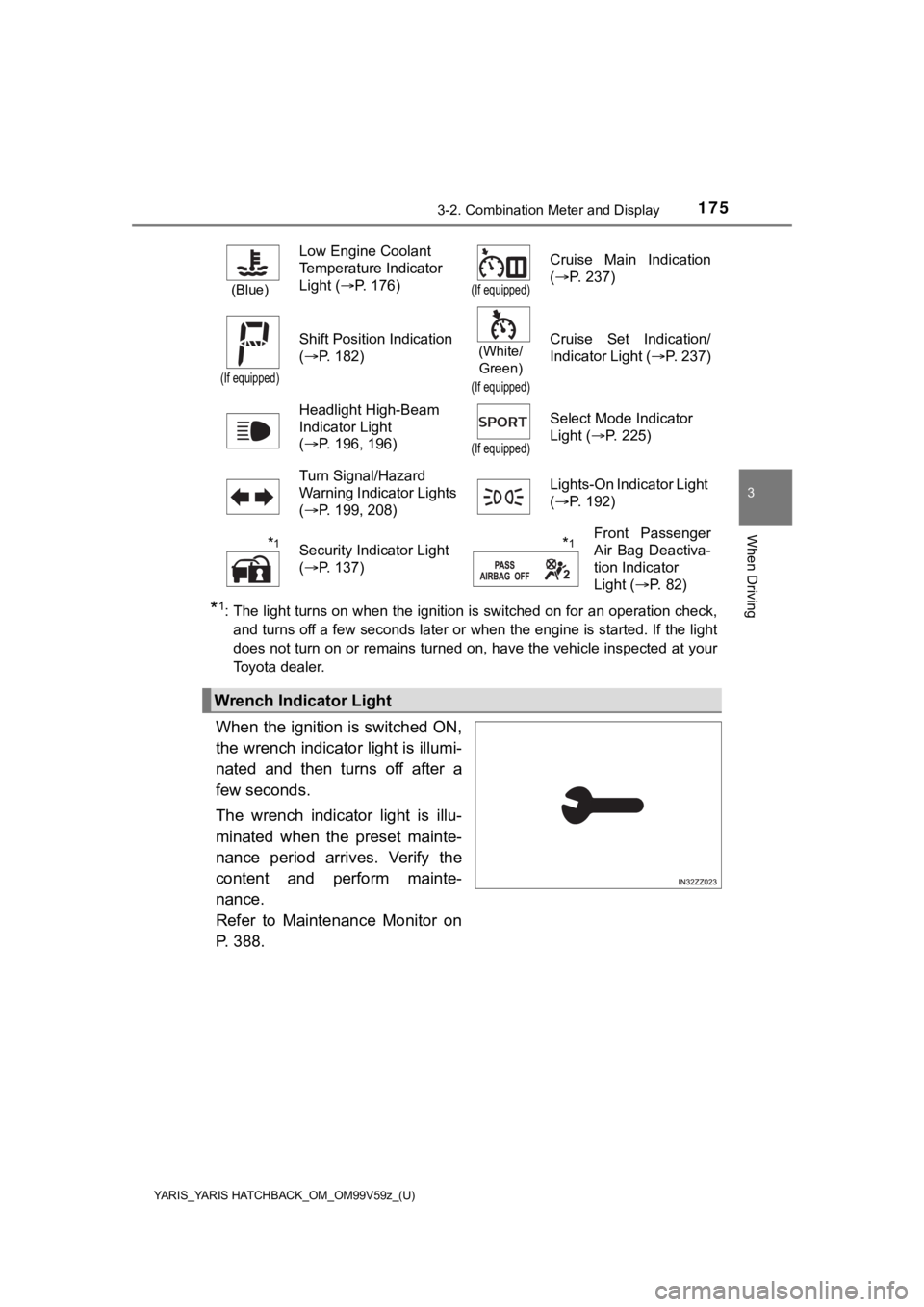
YARIS_YARIS HATCHBACK_OM_OM99V59z_(U)
1753-2. Combination Meter and Display
3
When Driving
*1: The light turns on when the ignition is switched on for an operation check,
and turns off a few seconds later or when the engine is started . If the light
does not turn on or remains turned on, have the vehicle inspect ed at your
Toyota dealer.
When the ignition is switched ON,
the wrench indicato r light is illumi-
nated and then turns off after a
few seconds.
The wrench indicator light is illu-
minated when the preset mainte-
nance period arrives. Verify the
content and perform mainte-
nance.
Refer to Maintenance Monitor on
P. 388.
(Blue)
Low Engine Coolant
Temperature Indicator
Light ( P. 176)
(If equipped)
Cruise Main Indication
(P. 237)
(If equipped)
Shift Position Indication
(P. 182)(White/
Green)
(If equipped)
Cruise Set Indication/
Indicator Light ( P. 237)
Headlight High-Beam
Indicator Light
( P. 196, 196)
(If equipped)
Select Mode Indicator
Light ( P. 225)
Turn Signal/Hazard
Warning Indicator Lights
( P. 199, 208) Lights-On Indicator Light
(
P. 192)
*1Security Indicator Light
(P. 137)*1Front Passenger
Air Bag Deactiva-
tion Indicator
Light ( P. 82)
Wrench Indicator Light
Page 182 of 572
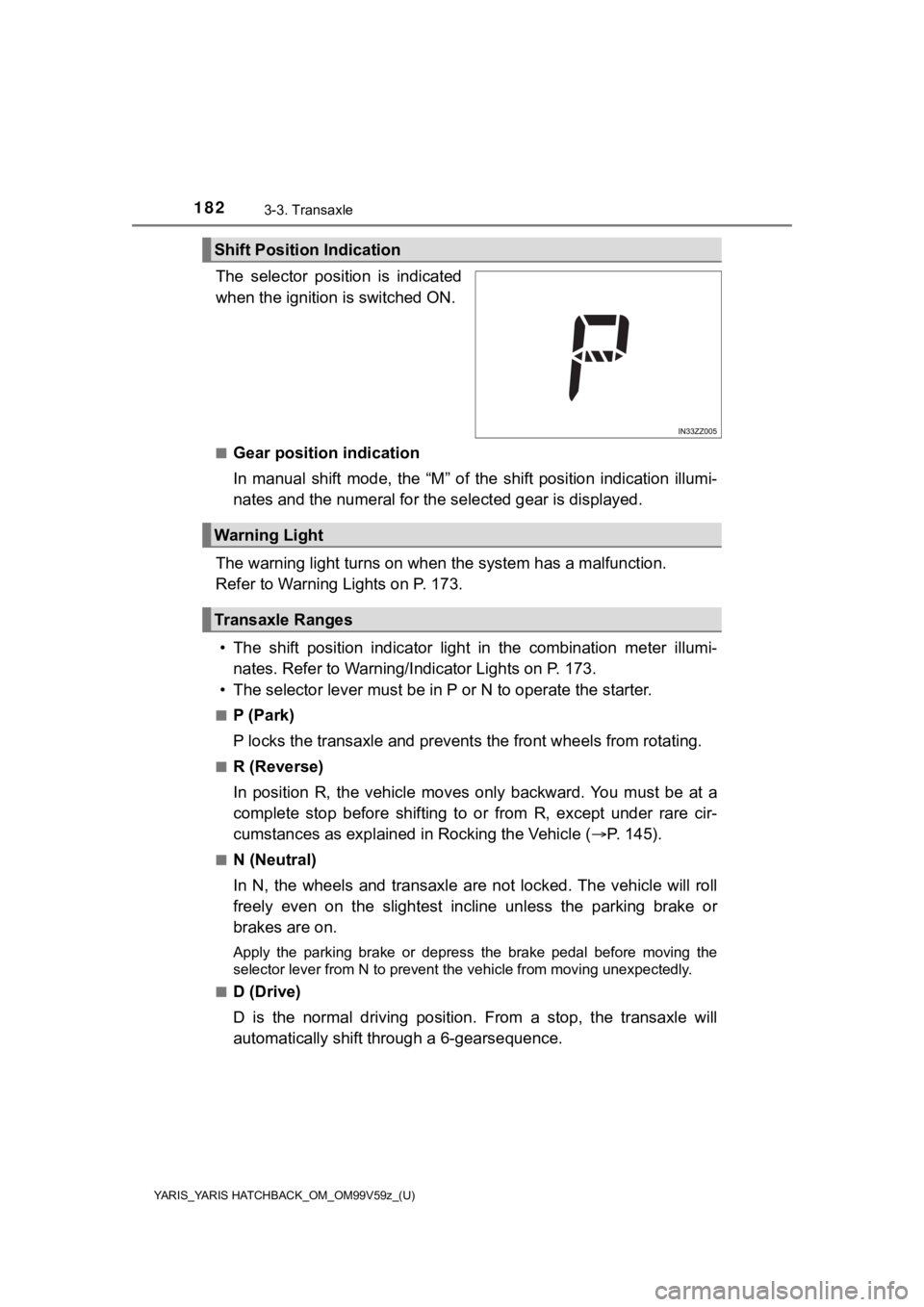
182
YARIS_YARIS HATCHBACK_OM_OM99V59z_(U)
3-3. Transaxle
The selector position is indicated
when the ignition is switched ON.
■Gear position indication
In manual shift mode, the “M” of the shift position indication illumi-
nates and the numeral for the selected gear is displayed.
The warning light turns on when the system has a malfunction.
Refer to Warning Lights on P. 173.
• The shift position indicator light in the combination meter il lumi-
nates. Refer to Warning/I ndicator Lights on P. 173.
• The selector lever must be in P or N to operate the starter.
■P (Park)
P locks the transaxle and prevent s the front wheels from rotating.
■R (Reverse)
In position R, the vehicle moves only backward. You must be at a
complete stop before shifting to or from R, except under rare c ir-
cumstances as explained i n Rocking the Vehicle (P. 145).
■N (Neutral)
In N, the wheels and transaxle a re not locked. The vehicle will roll
freely even on the slightest inc line unless the parking brake o r
brakes are on.
Apply the parking brake or depress the brake pedal before moving the
selector lever from N to prevent the vehicle from moving unexpe ctedly.
■
D (Drive)
D is the normal driving position. From a stop, the transaxle wi ll
automatically shift through a 6-gearsequence.
Shift Position Indication
Warning Light
Transaxle Ranges
Page 191 of 572
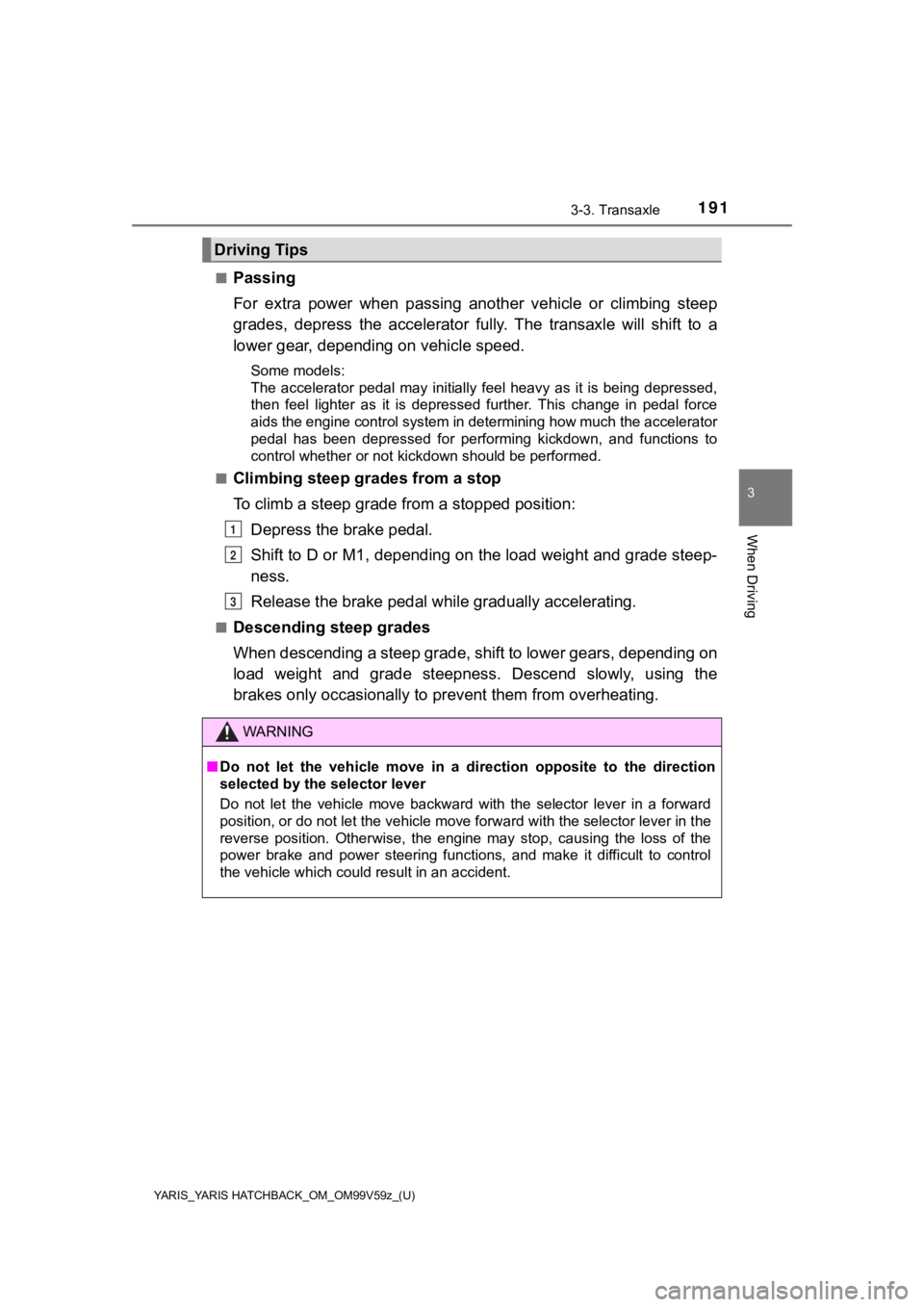
YARIS_YARIS HATCHBACK_OM_OM99V59z_(U)
1913-3. Transaxle
3
When Driving
■Passing
For extra power when passing another vehicle or climbing steep
grades, depress the accelerator fully. The transaxle will shift to a
lower gear, depending on vehicle speed.
Some models:
The accelerator pedal may initially feel heavy as it is being d epressed,
then feel lighter as it is depressed further. This change in pe dal force
aids the engine control system in determining how much the acce lerator
pedal has been depressed for performing kickdown, and functions to
control whether or not kickdown should be performed.
■
Climbing steep gra des from a stop
To climb a steep grade from a stopped position: Depress the brake pedal.
Shift to D or M1, depending on the load weight and grade steep-
ness.
Release the brake pedal wh ile gradually accelerating.
■Descending steep grades
When descending a steep grade, shift to lower gears, depending on
load weight and grade steepnes s. Descend slowly, using the
brakes only occasionally to p revent them from overheating.
Driving Tips
WARNING
■Do not let the vehicle move in a direction opposite to the direction
selected by the selector lever
Do not let the vehicle move backward with the selector lever in a forward
position, or do not let the vehicle move forward with the selec tor lever in the
reverse position. Otherwise, the engine may stop, causing the loss of the
power brake and power steering f unctions, and make it difficult to control
the vehicle which could result in an accident.
1
2
3
Page 208 of 572
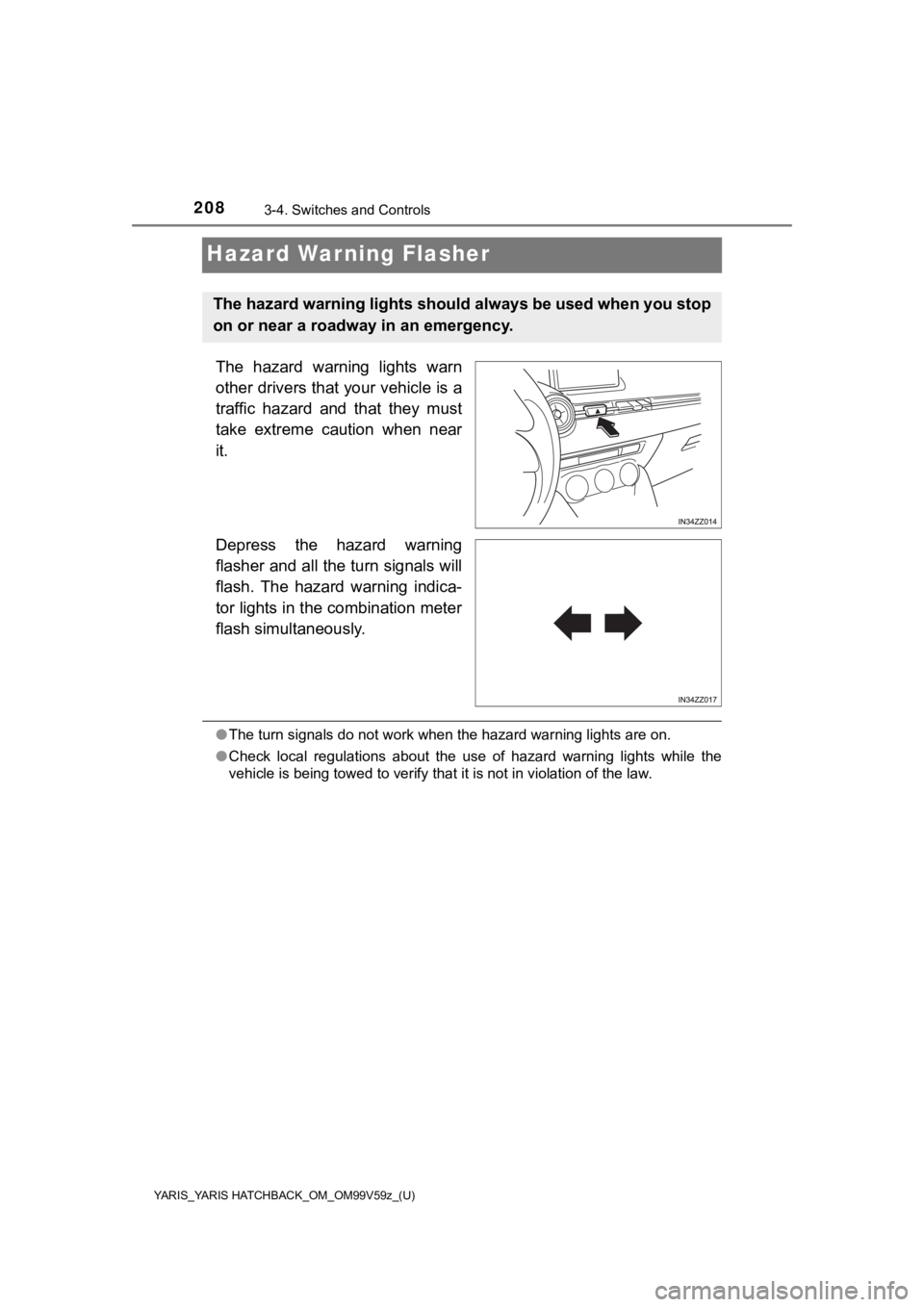
208
YARIS_YARIS HATCHBACK_OM_OM99V59z_(U)
3-4. Switches and Controls
Hazard Warning Flasher
The hazard warning lights warn
other drivers that your vehicle is a
traffic hazard and that they must
take extreme caution when near
it.
Depress the hazard warning
flasher and all the turn signals will
flash. The hazard warning indica-
tor lights in the combination meter
flash simultaneously.
●The turn signals do not work when the hazard warning lights are on.
● Check local regulations about the use of hazard warning lights while the
vehicle is being towed to verify that it is not in violation of the law.
The hazard warning lights should always be used when you stop
on or near a roadway in an emergency.
Page 209 of 572
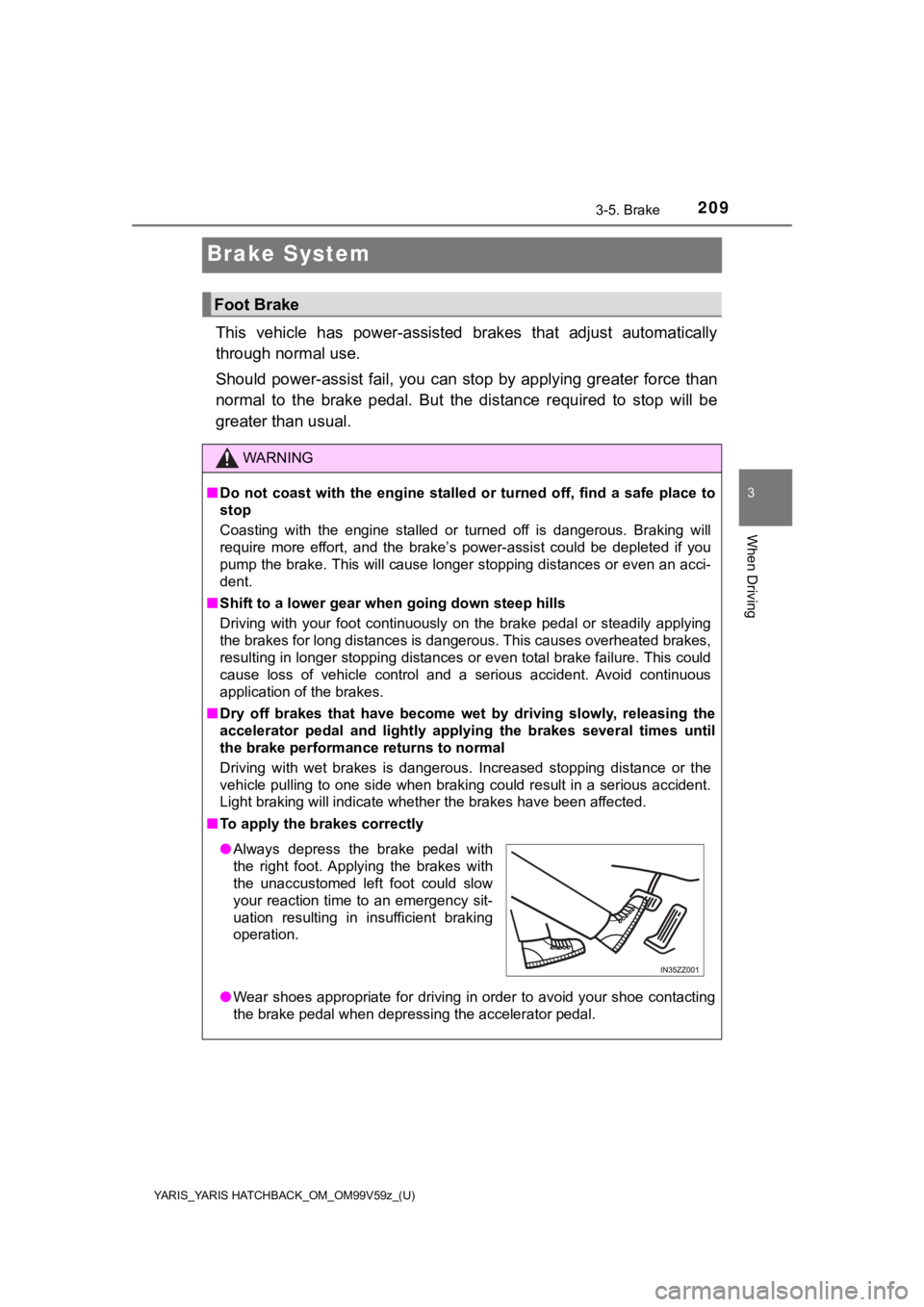
209
YARIS_YARIS HATCHBACK_OM_OM99V59z_(U)
3-5. Brake
3
When Driving
Brake System
This vehicle has power-assisted brakes that adjust automatically
through normal use.
Should power-assist fail, you can stop by applying greater forc e than
normal to the brake pedal. But the distance required to stop wi ll be
greater than usual.
Foot Brake
WARNING
■ Do not coast with the engine stalled or turned off, find a safe place to
stop
Coasting with the engine stalled or turned off is dangerous. Br aking will
require more effort, and the brake’s power-assist could be depleted if you
pump the brake. This will cause longer stopping distances or even an acci-
dent.
■ Shift to a lower gear whe n going down steep hills
Driving with your foot continuously on the brake pedal or steadily applying
the brakes for long distances is dangerous. This causes overheated brakes,
resulting in longer stopping distances or even total brake fail ure. This could
cause loss of vehicle control and a serious accident. Avoid con tinuous
application of the brakes.
■ Dry off brakes that have become wet by driving slowly, releasin g the
accelerator pedal and lightly applying the brakes several times until
the brake performance returns to normal
Driving with wet brakes is dangerous. Increased stopping distan ce or the
vehicle pulling to one side when braking could result in a seri ous accident.
Light braking will indicate whether the brakes have been affect ed.
■ To apply the brakes correctly
● Wear shoes appropriate for driving in order to avoid your shoe contacting
the brake pedal when depressing the accelerator pedal.
● Always depress the brake pedal with
the right foot. Applying the brakes with
the unaccustomed left foot could slow
your reaction time to an emergency sit-
uation resulting in insufficient braking
operation.
Page 211 of 572
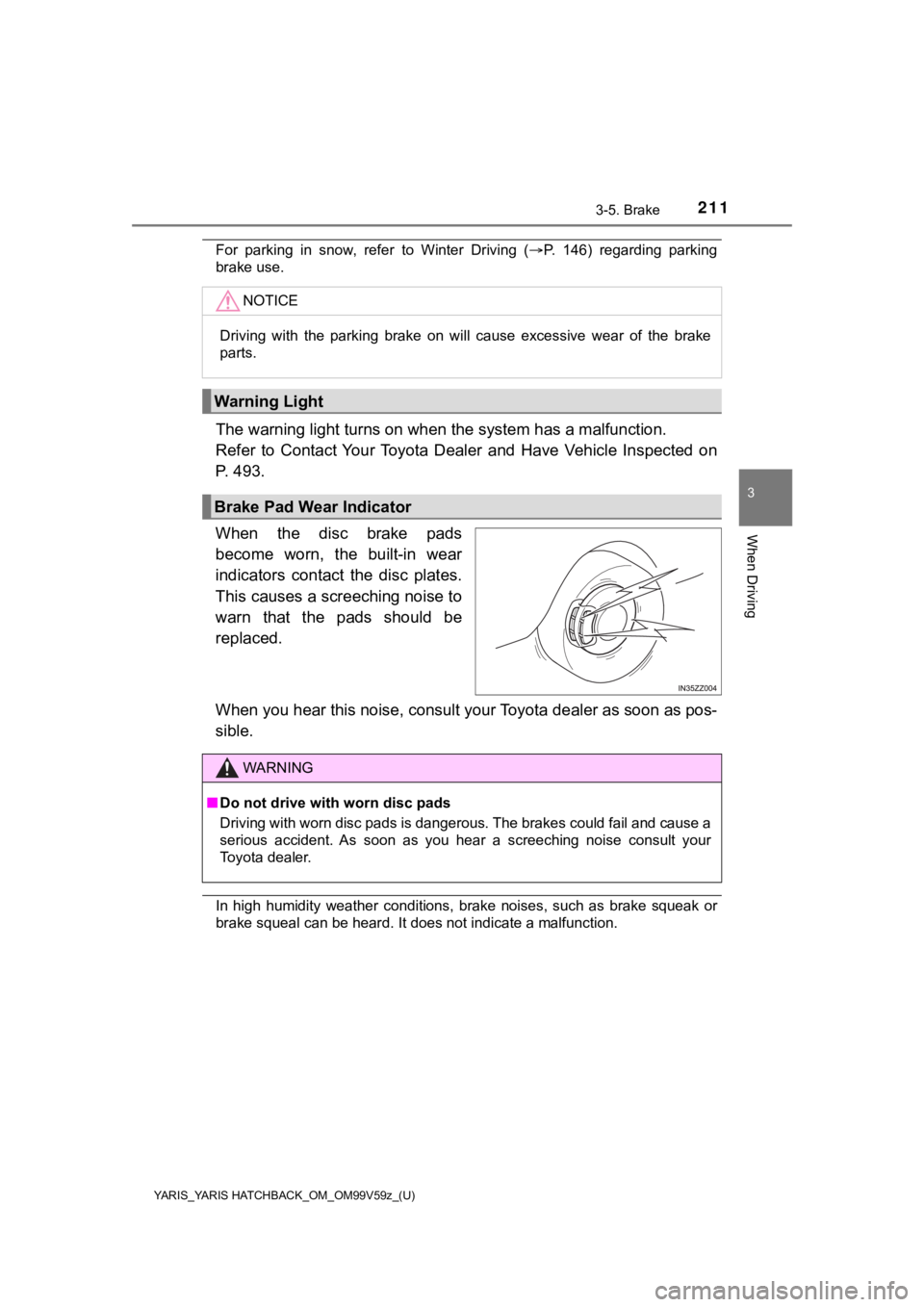
YARIS_YARIS HATCHBACK_OM_OM99V59z_(U)
2113-5. Brake
3
When Driving
For parking in snow, refer to Winter Driving (P. 146) regarding parking
brake use.
The warning light turns on when the system has a malfunction.
Refer to Contact Your Toyota Dealer and Have Vehicle Inspected on
P. 493.
When the disc brake pads
become worn, the built-in wear
indicators contact the disc plates.
This causes a screeching noise to
warn that the pads should be
replaced.
When you hear this noise, consul t your Toyota dealer as soon as pos-
sible.
In high humidity weather conditions, brake noises, such as brake squeak or
brake squeal can be heard. It does not indicate a malfunction.
NOTICE
Driving with the parking brake on will cause excessive wear of the brake
parts.
Warning Light
Brake Pad Wear Indicator
WARNING
■ Do not drive with worn disc pads
Driving with worn disc pads is dangerous. The brakes could fail and cause a
serious accident. As soon as you hear a screeching noise consult your
Toyota dealer.
Page 215 of 572
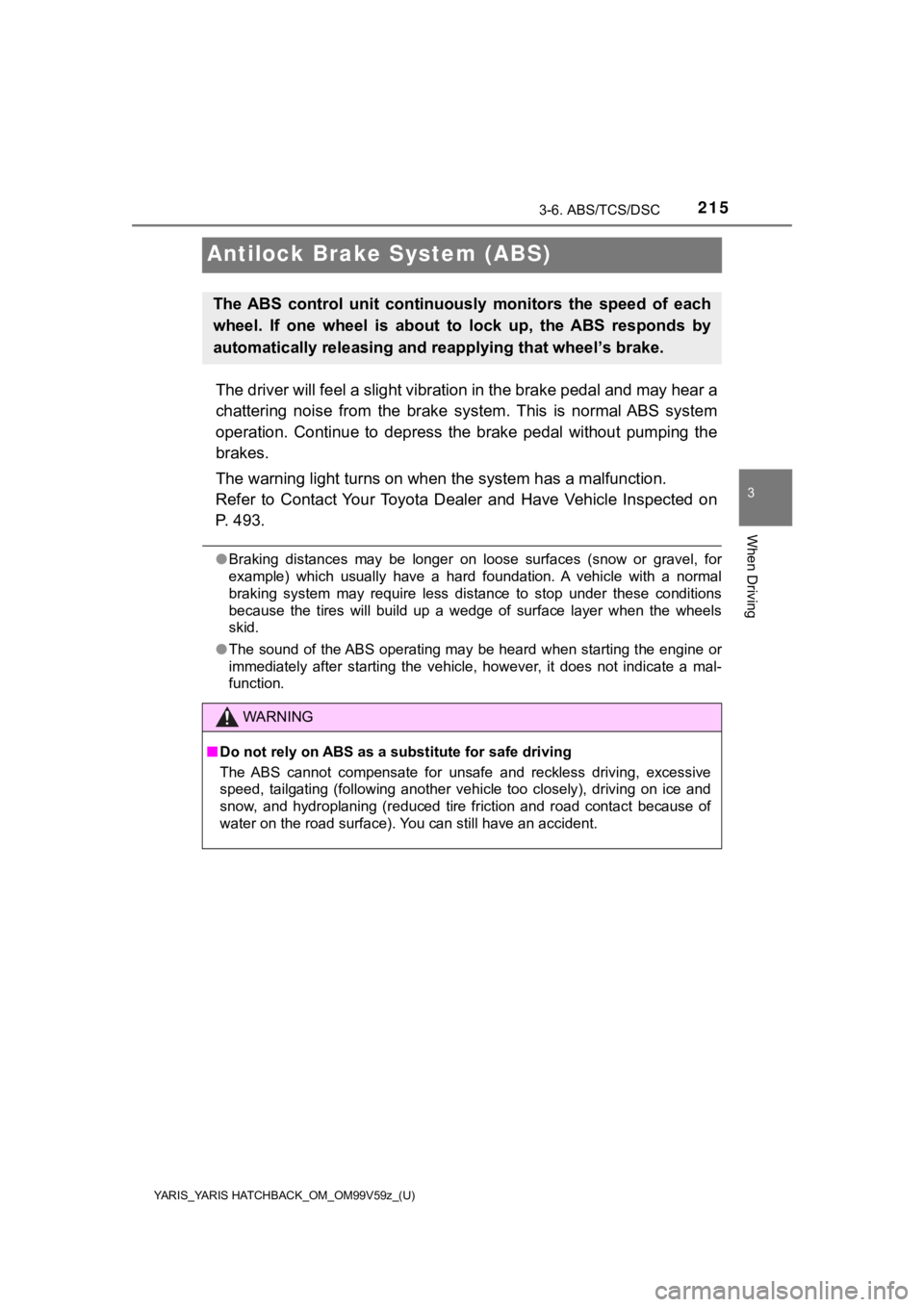
215
YARIS_YARIS HATCHBACK_OM_OM99V59z_(U)
3-6. ABS/TCS/DSC
3
When Driving
Antilock Brake System (ABS)
The driver will feel a slight vibration in the brake pedal and may hear a
chattering noise from the brake system. This is normal ABS syst em
operation. Continue to depress the brake pedal without pumping the
brakes.
The warning light turns on when the system has a malfunction.
Refer to Contact Your Toyota Dealer and Have Vehicle Inspected on
P. 493.
● Braking distances may be longer on loose surfaces (snow or grav el, for
example) which usually have a hard foundation. A vehicle with a normal
braking system may require less distance to stop under these co nditions
because the tires will build up a wedge of surface layer when t he wheels
skid.
● The sound of the ABS operating may be heard when starting the engine or
immediately after starting the vehicle, however, it does not in dicate a mal-
function.
The ABS control unit continuously monitors the speed of each
wheel. If one wheel is about to lock up, the ABS responds by
automatically releasing and reapplying that wheel’s brake.
WARNING
■ Do not rely on ABS as a su bstitute for safe driving
The ABS cannot compensate for unsafe and reckless driving, exce ssive
speed, tailgating (following another vehicle too closely), driv ing on ice and
snow, and hydroplaning (reduced tire friction and road contact because of
water on the road surface). You can still have an accident.
Page 216 of 572
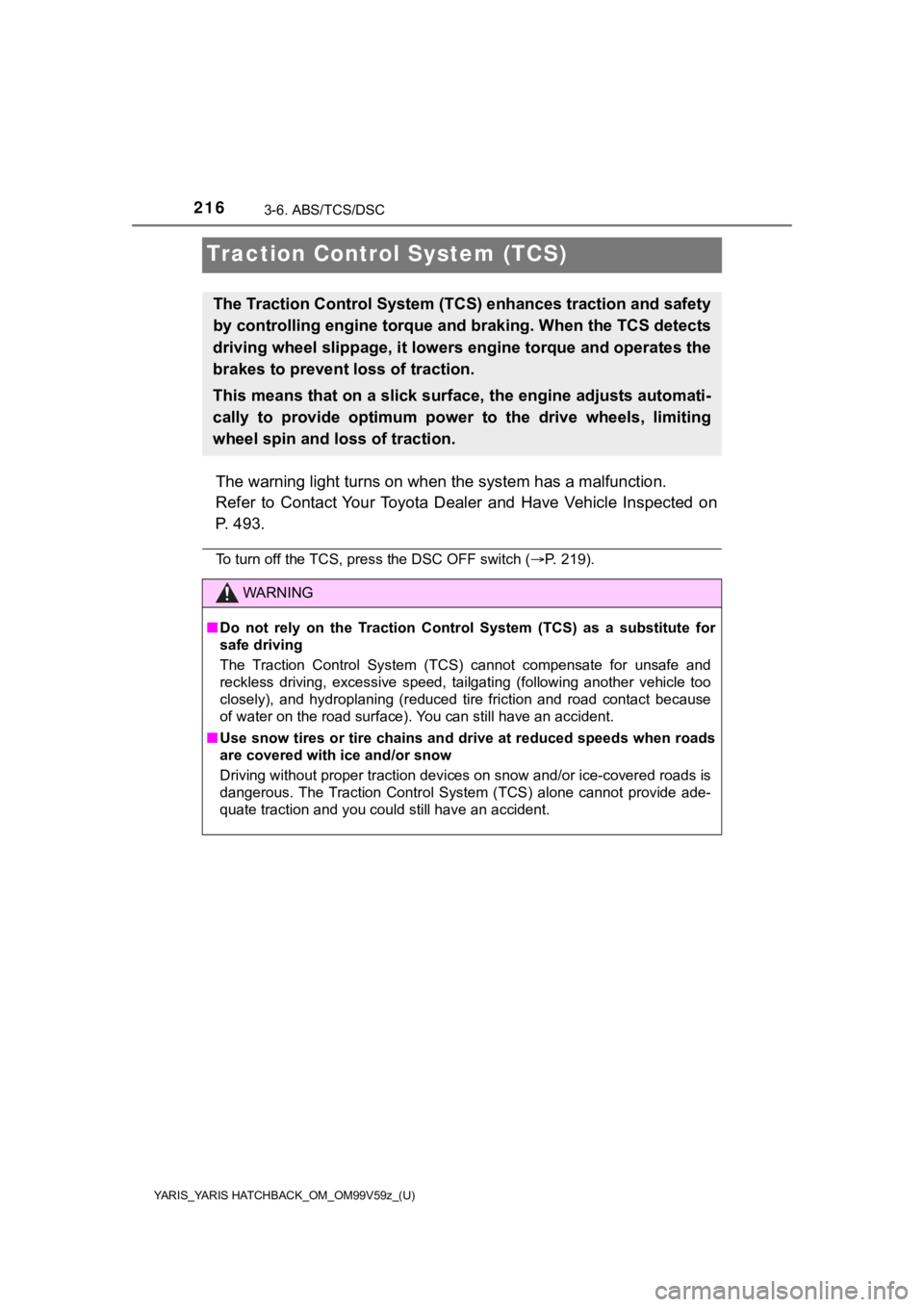
216
YARIS_YARIS HATCHBACK_OM_OM99V59z_(U)
3-6. ABS/TCS/DSC
Traction Control System (TCS)
The warning light turns on when the system has a malfunction.
Refer to Contact Your Toyota Dealer and Have Vehicle Inspected on
P. 493.
To turn off the TCS, press the DSC OFF switch ( P. 219).
The Traction Control System (TCS) enhances traction and safety
by controlling engine torque and braking. W hen the TCS detects
driving wheel slippage, it lower s engine torque and operates th e
brakes to prevent loss of traction.
This means that on a slick surface , the engine adjusts automati-
cally to provide optimum power to the drive wheels, limiting
wheel spin and loss of traction.
WARNING
■ Do not rely on the Traction Cont rol System (TCS) as a substitute for
safe driving
The Traction Control System (TCS) cannot compensate for unsafe and
reckless driving, excessive speed, tailgating (following anothe r vehicle too
closely), and hydroplaning (reduced tire friction and road contact because
of water on the road surface). You can still have an accident.
■ Use snow tires or tire chains and drive at reduced speeds when roads
are covered with ice and/or snow
Driving without proper traction devices on snow and/or ice-cove red roads is
dangerous. The Traction Control System (TCS) alone cannot provide ade-
quate traction and you could still have an accident.